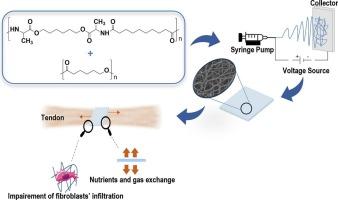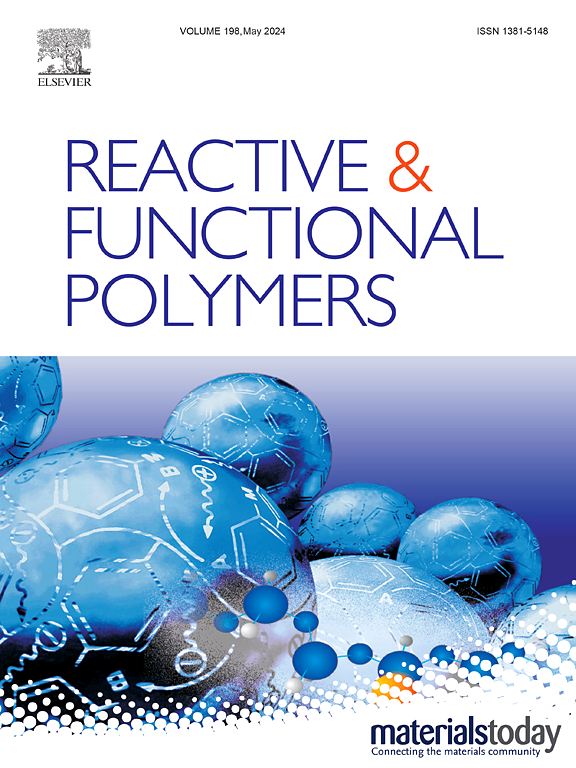α-氨基酸基聚(酯酰胺)电纺纤维垫:预防肌腱粘连的理想材料
IF 4.5
3区 工程技术
Q1 CHEMISTRY, APPLIED
引用次数: 0
摘要
术后肌腱粘连的发生仍然是临床上的一个主要问题,它与肌腱活动范围的丧失有关,并影响患者的活动度和舒适度。减少这些并发症的方法之一是在受伤部位和周围区域之间使用物理屏障。在这项研究中,聚(ε-己内酯)(PCL)和L-丙氨酸基聚(酯酰胺)(PEA_ala)的电纺垫被提议作为一种可能的抗粘连物理屏障。我们测试了不同 PCL/PEA_ala 比率的垫子和不同分子量的 PEA。试验结果表明,PCL/PEA_ala 比例不同的垫子和不同分子量的 PEA 具有适当的孔隙率,允许白蛋白通过,这表明垫子适用于营养物质和细胞废料的交换。无论是圆形还是扁平形,孔隙大小都在成纤维细胞大小以下的范围内,这是干扰成纤维细胞进入损伤部位的关键属性。体外水解降解测试表明,聚乙二醇醚的存在促进了材料的降解。在机械性能方面,研究表明 PEAs 的存在有助于改善垫子的这些性能。此外,还进行了摩擦测试,结果表明,垫子中 PEA 的存在有助于降低动态摩擦系数。体外细胞毒性测试表明,垫子对成纤维细胞没有细胞毒性,但 PEA 的存在导致成纤维细胞粘附力下降。总之,所获得的结果证明了所开发的电纺垫在防止肌腱粘连方面的潜力。本文章由计算机程序翻译,如有差异,请以英文原文为准。

Electrospun mats from α-amino acid based poly(ester amide)s: A promising material for the prevention of tendon adhesions
The occurrence of postoperative tendon adhesions remains a major problem in the clinic and is related to the loss of tendon range of motion and affects patient mobility and comfort. One way to reduce these complications is to use physical barriers between the injury site and the surrounding area. In this study, electrospun mats of poly(ε-caprolactone) (PCL) and L-alanine-based poly(ester amide)s (PEA_ala) is proposed as a possible anti-adhesion physical barrier. Mats with different PCL/PEA_ala ratios and PEAs with different molecular weights were tested. The mats exhibited suitable porosity to allow the passage of albumin, indicating that they are suitable for the exchange of nutrients and cell waste materials. The pore size is in a range below the size of fibroblasts, both in their round and flattened shapes, a critical attribute for interfering with fibroblast entry into the injury site. The in vitro hydrolytic degradation tests showed that the presence of PEAs contributes to an enhanced degradation of the material. In terms of mechanical properties, it was shown that the presence of PEAs contributed to an improvement of these properties in the mats. Additionally, friction tests were carried out and the results showed that the presence of the PEAs in the mats contributed to a decrease in the dynamic friction coefficient. In vitro cytotoxicity tests showed that the mats were not cytotoxic to fibroblasts, but the presence of PEAs led to a decrease in fibroblast adhesion. Overall, the results obtained demonstrate the potential of the developed electrospun mats in preventing tendon adhesions.
求助全文
通过发布文献求助,成功后即可免费获取论文全文。
去求助
来源期刊

Reactive & Functional Polymers
工程技术-高分子科学
CiteScore
8.90
自引率
5.90%
发文量
259
审稿时长
27 days
期刊介绍:
Reactive & Functional Polymers provides a forum to disseminate original ideas, concepts and developments in the science and technology of polymers with functional groups, which impart specific chemical reactivity or physical, chemical, structural, biological, and pharmacological functionality. The scope covers organic polymers, acting for instance as reagents, catalysts, templates, ion-exchangers, selective sorbents, chelating or antimicrobial agents, drug carriers, sensors, membranes, and hydrogels. This also includes reactive cross-linkable prepolymers and high-performance thermosetting polymers, natural or degradable polymers, conducting polymers, and porous polymers.
Original research articles must contain thorough molecular and material characterization data on synthesis of the above polymers in combination with their applications. Applications include but are not limited to catalysis, water or effluent treatment, separations and recovery, electronics and information storage, energy conversion, encapsulation, or adhesion.
 求助内容:
求助内容: 应助结果提醒方式:
应助结果提醒方式:


